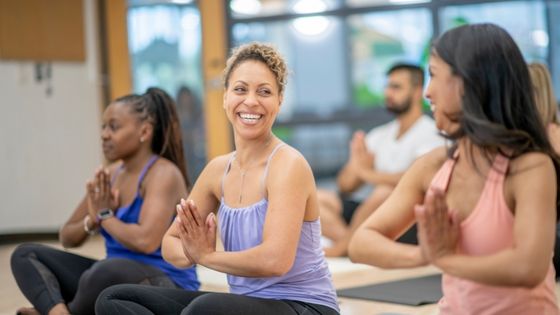Contrary to what modern media and advertisers would have us believe, yoga involves a wide range of introspective and self-disciplined activities, including mindfulness, mantras, chanting, breathing practice, ritual, and then even altruistic action. The root “yuj,” which means “to yoke” or “to bind,” is where the term “yoga” originates.
The idea of connection is at the heart of the word’s many meanings, which range from astronomical conjunction to marriages. Asana is the term for yoga’s positions and their physical application. The vast majority of data seems to corroborate what practitioners have undoubtedly known for thousands of years: the benefits of yoga for our total well-being, even though scientific research into its health benefits is still in its infancy. Yoga has been practiced for many years as a spiritual, mental, and physical discipline. Over time, people have discovered the many health benefits of the regular practice of yoga. In addition to aiding in weight loss and muscle gain, yoga is a workout that involves both the body and the mind.
Aids in reducing persistent low back discomfort
Your low back, shoulders, and neck may hurt if you sit at a desk (or couch) all day due to bad posture. Yoga helps with posture, which can reduce the risk of low-back discomfort as well as shoulder and neck pain. Yoga encourages the alleviation of low back pain in two ways: Yoga promote relaxation from the physical discomfort associated with persistent low-back pain. The poses themselves are the next: One of the main therapeutic modalities for managing low-back pain is exercise, which also helps with posture by enhancing core strength and stability. Yoga truly seems to be better than the usual standard of care in reducing people’s perceptions of the severity of chronically low pain or even how disturbed they are almost by their discomfort. One must try to get involved in this spiritually blessed world and try Yoga for good health, mental stability and consistency in life.
Enhances physical awareness
Many large and tiny muscles are used when you ground your body to maintain all the positions. Yoga also emphasizes perfect form, which helps you learn how your muscles, joints, and tissues interact. To do this, you must engage the appropriate muscles. Doing this can help you move securely. Yoga is a technique that emphasizes alignment. To use our muscles and release active energy as effectively as possible, we learn to stack and align our joints, it increases body awareness so that we can engage in life with greater physical freedom and less discomfort. For instance, when performing the Tree pose, which includes standing on one leg, your inner thighs, quadriceps, and core are actively engaged to support your balance and prevent you from falling. This also increases your awareness of where your ankle, hip, and shoulder joints are located and how tendons and other soft tissues support those joints to keep you in alignment as well as balance.
Reduces tiredness
Your heart pumps additional oxygen-rich blood to your tissues and systems when you move, such as by practicing some yoga stretches throughout the day.
Yoga program reduces the feeling of stress, and weariness, as well as enhances the overall health-related quality of life. Hatha yoga has been shown to have similar advantages for reducing fatigue. Inversion poses, in which your heart is greater than your head, could be particularly beneficial for boosting energy. The Forward Fold, as well as Downward Facing Dog, are examples of these stances.
Encourages balance
Yoga postures that demand balance, such as Warrior III, Chair, Eagle, Tree, and Crow, help test your stability since they call on you to use certain stabilizing muscles when you remove a base of support, like when standing on one leg. Your equilibrium will improve as a result, which is crucial as you age. People frequently lose mobility as they get older as a result of inactivity, arthritis, and other age-related illnesses.
But studies reveal that persons over 60 who practice certain yoga-based exercises have greater balance and flexibility. Improved balance can lower the chance of injury and boost sports performance. This is because better balance gives you better awareness to activate the appropriate muscles to support stability. Imagine completing a single-leg pull. By engaging the correct muscles—your core, lats, and the buttocks on your working leg—you’ll become able to complete the exercise more successfully, which will aid in your development of strength.
Increases strength
Even if yoga isn’t precisely famous for building strength in the same manner that weight lifting is, practicing postures will still effectively give you the identical advantages of carrying out bodyweight exercises. For instance, maintaining Chair posture is comparable to completing a squat, while progressing through Chaturanga entails doing a push-up and a plank.
The positions we practice may seem simple, but holding them for prolonged periods of time requires exercise in and of itself. Vinyasa or Ashtanga asana practices, which are more vigorous, may help you feel the advantages of increased strength even more quickly. Depending on the type of yoga you practice, the isometric holds are mostly responsible for the benefits to your muscles. Exercises that entail isometric contraction, like the plank, involve engaging a muscle or a muscle group without moving the joint that surrounds the muscle. This makes this type of exercise perfect for persons who are healing from an accident or having joint problems. Isometric exercises are necessary to increase muscle strength and performance, even though they are not the best for building bigger muscles.
Even while the research is still in its early stages (particularly in light of how long people have been practicing yoga), the results show that there are various health benefits of Yoga, which is in line with what yoga practitioners have been claiming for thousands of years. Most of the disciplines that belong under the yogic umbrella place more emphasis on meditation techniques than on physical exercise. Yoga could be good deeds or karma! Yoga requires more than just physical activity, so you might do it daily.




















